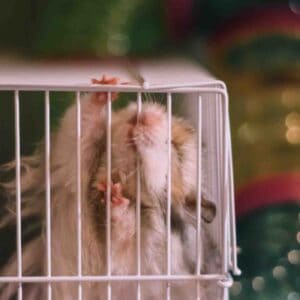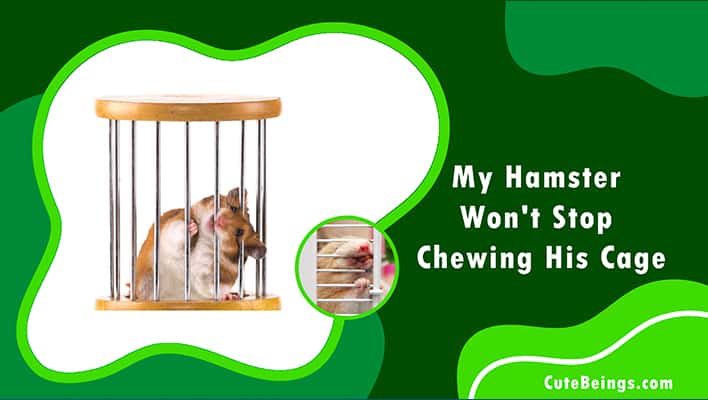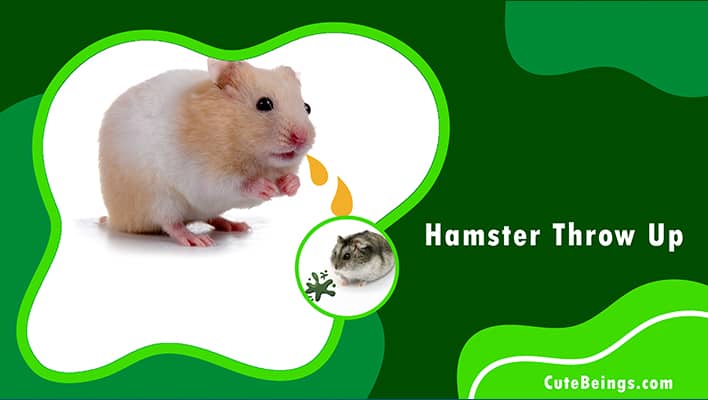Like other rodents, hamsters enjoy chewing on objects, and cage bars are no different. Although hamsters naturally chew, certain objects, such as cage bars, can be dangerous. Major problems can be avoided by locating safer alternatives for your hamster to gnaw on and by understanding why your “hamster chewing cage at night” or “hamster chews cage all night”.
Table of Contents
Why won’t my hamster stop chewing the bars?

They chew the bars for several reasons.
Teeth growing
Do you know hamsters’ teeth never stop growing? Therefore, they always have to chew. Hamsters have teeth that continue to erupt throughout their brief lives, unlike humans. As a result, they must chew to keep the teeth in shape. Otherwise it grows bigger.. A hamster may find that the food supplied to them doesn’t offer enough chewing motion, so they turn to other objects in their cage to nibble on.
Small cage
According to many researchers, a minimum hamster cage size is 20 gallons, but they also advise getting the biggest cage you can afford. The bare minimum for a hamster tank is 20 gallons.
While some hamster care specialists recommend a cage be no smaller than 360 square inches, others recommend as much as 450 square inches. And of course, that only applies to one hamster.
If you have more than one hamster in a cage they will get into a fight due to lack of space. Most importantly, you should never keep more than one Syrian hamster in a cage.
If your cage is smaller than the required 360 square inches, your hamster may be showing signs of feeling restricted if they are chewing on bars.
The fact that hamsters aren’t used to living in such a small space. In their native environment, hamsters are allowed to move freely. Furthermore, the environment they would live in in the wild is completely different from that of a cage. When the cage is too small, the hamster will attempt to escape by literally gnawing his way out due to his inherent nature.
Discover the appropriate hamster cage dimensions for your beloved furry friend , ensuring they have ample space to roam, play, and dwell comfortably.
Anxiety/stress
To relieve stress brought on by a variety of environmental factors, hamsters may start chewing on bars. Cats that show excessive attention, young children who don’t know how to handle an animal gently, undersized cages, and uncomfortable beddings that irritate a hamster’s lungs and skin are common examples of stress.
Habit

Unfortunately, it is really difficult to break this behavior. primarily because it kind of has an addiction to hamsters. Even though it might make you shudder, they enjoy the sound and sensation of their teeth scraping against the bars.
So it will be quite challenging to convince your hamster to give up something he loves. The best solution for this is to fully eliminate the bars. That men you can place them in a glass tank
No matter how big their cage is, hamsters who have a penchant for chewing the bars will still find the corners and do so.
Need attention/curiosity
Hamsters are very inquisitive and will want to investigate everything. They will nonetheless attempt to examine that sound despite their fear.
They typically look inside or listen to items because they are on the lookout for predators. However, a pet hamster will have the courage to approach the cage bars and attempt to see, hear, and smell what is causing that to make those noises.
Sometimes they try to get attention by chewing the cage bar. Give the hamster some attention in these situations, but be cautious.
Do not touch him directly if you hear him grinding his teeth or notice that he is agitated and jittery. A hamster that is chattering its teeth is not amusing. Although he is perceptive, his sudden burst of energy makes him uncontrollable and prone to biting.
Why is my hamster chewing so much?
The first thing you need to know is that hamsters instinctively gnaw on stuff. Their incisor teeth are always developing, so it’s a biological requirement that chewing helps control the size of these teeth.
There should be no shortage of secure chew toys available for hamsters to enjoy. It might be acceptable if a hamster continues to gnaw on the cage bars occasionally. However, occasionally, biting on the bars gets excessive, and this can damage your hamster’s teeth.
How to stop hamster from bar chewing
Now we can look for ways to stop hamster from chewing their cage. Depending on the size, breed and preferences of the hamster you might have to take one or all actions given below.
Distract your hamster
You can get them an exercise wheel. At first, you can use a little piece of paper towel to help your hamster navigate through his cage and into the wheel. The hamster will then attempt to reach the paper towel or your hand. However, if you put it in front of them while still on the wheel, the hamster will eventually start running toward you. You can do this several times a day or whenever your hamstring becomes tense. For added interest, sometimes allow him access to the paper towel.
Or you can get them a hamster ball. As soon as the hamster is in the exercise ball, you may give them free reign of the house as long as you don’t let each session last longer than 30 minutes. Also, make certain that it will not fall down any stairs. A playful cat or a barking dog will frighten the hamster and make him feel worse.
However, workout balls can be quite loud. The hamster will knock it against anything. In order to let your hamster run around, you can either soundproof the area or accept the noise. To avoid being hit, you can cover the surfaces of the ball. Or, if there are any awkward corners, you can simply put a slipper in the way to stop the hammy from going around that corner.
To distract your hamster, you can also play with it. Again, it’s better to avoid direct contact with the hamster if his teeth are chattering and have an off-putting expression. Give it a puzzle toy or set up an obstacle course in its cage with a piece of cardboard and some tape. If it appears to be relatively peaceful, you can also pick it up. Let the hamster play, and run over your hands as you normally would. But if it appears poised to escape from your grasp, stay as close as possible to its cage.
Introduce toys
Your hamster will benefit if you buy or make some chew toys and scatter them around his cage. As a result, your hamster will have numerous opportunities to chew on objects within their cage. Your hammy will frequently require something made of wood to gnaw on. Even if your hamster enjoys biting on the cage bars, they are too hard for his teeth to handle.
Therefore, you’ll need to provide them with some chew toys. In reality, your hamster won’t benefit much from mineral chews. They are advertised as a chewing aid and are meant to supplement your hamster’s diet with more minerals.
Other things you can do
- Give fruit branch to chew. (ex: Apple)
- Block hamsters favorite chewing spot.
- Give a stainless steel spoon.
- Put some unsalted nuts in the cage.
What can I put on bars to stop hamster chewing?
After you do all the right things, some hamsters stop chewing the cage bar. In those cases you can try following options
- You can put some oil on the cage bar
Hamsters are prevented from chewing on the hamster cage bars by leaving oil on them because of its texture and flavor. However, you should think twice when deciding which oil to use. It is better to use extra-light olive oil. Hamsters will lick the bars rather than chew them because of the difference in taste. However, using a different oil than olive oil may result in hamster obesity. - Bitter sprays
This spray is safe for hamsters. But never directly spray it on the hamster. If you spray this everywhere, hamsters will lose their appetite. So before spraying, remove the hamster and its bedding from the cage. Only spray the cage bars.
Hamster chewing wooden cage
Unquestionably, the cutest, most natural, and most elegant cage for a hamster is made of wood. Due to its natural wood design, it’s a great way to provide a natural-themed cage for your pet hamster. However, if you find one without plastic layering, the wood may absorb moisture and liquid, causing the cage to smell or to grow bacteria. Additionally, you cannot fully wash a wooden cage and then only clean it with wipes. Yes, your hamster can unquestionably chew through the woods. Even Though you provide so much space and treats they will chew through wood and escape. So the better solution is a glass tank.
Hamster chewing on plastic cage
Due to previously mentioned reasons hamsters might chew plastic cages. It is easy for them to chew plastic.
Mainly chewing plastic is harmful to hamsters. If your hamster continues to chew on the plastic of its cage, it could come off and suffocate. Second, the paint on plastic cages is hazardous. These could harm your hamster’s digestive tract if it consumes them.If you don’t notice your hamster gnawing on its plastic cage excessively, it could even be fatal. Thus, it can undoubtedly become serious.
How can I stop my hamster chewing the plastic cage
You can do a few things to make them stop chewing the plastic cage.
- Provide a larger cage
- Give them toys to chew
- Play with them
- Provide a glass tank
Frequently Asked Questions (FAQ)
Will lemon juice stop my hamsters chewing bars?
Yes, but it is not recommended. These animals do not like the lemon taste. If you apply lemon juice to the cage bars they might stop chewing. But it also makes them stop eating other food. So use this method as a last resort.
Vinegar on hamster cage bars
Hamsters also do not like the taste of vinegar. As I mentioned above they might stop chewing bars after applying vinegar. But that might affect your pet’s appetite.
Syrian hamster won’t stop chewing cage
If your syrian hamster won’t stop chewing its cage. That may be due to boredom, stress or teething. I have explained reasons and prevention methods in details in this article.

Hello, my name is James and I’ve been caring for tiny pets for over 14 years with a passion. I enjoy passing on my expertise to other individuals in order for them to have the same amount of enjoyment as I do.




